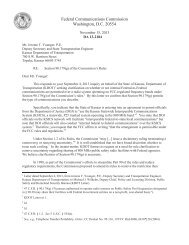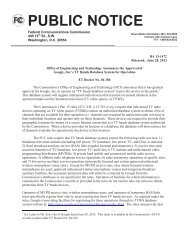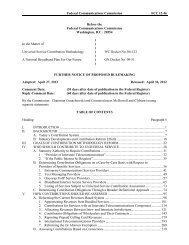FOR IMMEDIATE RELEASE: News Media contact: December ... - FCC
FOR IMMEDIATE RELEASE: News Media contact: December ... - FCC
FOR IMMEDIATE RELEASE: News Media contact: December ... - FCC
You also want an ePaper? Increase the reach of your titles
YUMPU automatically turns print PDFs into web optimized ePapers that Google loves.
eported cable capacity accounts for 11.3% of the total available fiber optic cable capacity, as of<br />
<strong>December</strong> 31, 1999.<br />
Note that cable capacity reported here likely understates the actual amount of capacity that is in use. For<br />
example, this year’s reported cable capacity (activated and idle combined) is relatively small, only<br />
accounting for 20% of total available (in operation) cable capacity. Due to the reasons cited in the<br />
footnote, 7 we recognize that there might be substantial amount of cable capacities that are in use but<br />
were not covered in our report. This discrepancy could also apply to satellite capacity since many<br />
private satellite operators are marketing their capacity directly to end-users and were not subject to our<br />
reporting requirements. 8 Table 7 also demonstrates the trend that most of the newly activated fiber optic<br />
cables and especially the cables planned from 2001 and 2002, even with their initial capacity before<br />
reaching maximum potential capacity, have far larger capacities than the older existing cables.<br />
7 In the past, we have identified two reasons that caused the discrepancy between reported capacity versus available<br />
capacity. One was foreign carriers' holding of the U.S. half of international cable capacity, about 20 to 25% of any particular<br />
cable system. Those foreign carriers are not required to report their capacity under Section 43.82 unless they use their<br />
capacity for the provision of U.S. international service. The other reason was the time-delay for country-specific information<br />
for any new cable system. That could have caused another 30-40% of capacity to be under-reported. However, there is third<br />
reason, which could cause a high level of unreported capacity. Under our Section 43.82, only common carriers are required<br />
to report the use of their international facility. There are increasing numbers of new non-common carrier cables being built<br />
and much of the capacity on those private cables was sold to end users, such as Internet Service Providers (ISPs) or to foreign<br />
carriers. Under those circumstances, neither cable owners nor cable users were required to report those capacities used. For<br />
example, in 1999, approximately 70% of total available capacity are from non-common carrier cables (see Table 7).<br />
8 The calculation for total U.S. satellite available capacity is different from the calculation for total U.S. available cable<br />
capacity. Due to the flexible nature of satellite coverage, each satellite can cover various countries and can be available to all<br />
those countries within its footprint. Therefore, there is no way of calculating the fixed amount of capacity that can be<br />
allocated to any given country at any specific time frame. On the other hand, fiber optic cables are fixed because they<br />
deployed only to their planned cable stations, therefore, it is possible to calculate the total cable available capacity on a<br />
particular route at any given time frame.<br />
4
















